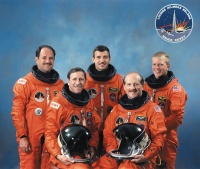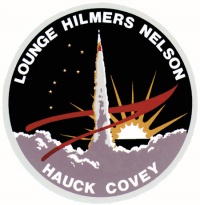STS-26
From The Space Library
 | |
| Organization | NASA-OfficeofSpaceFlight(UnitedStates) |
|---|---|
| Mission type | Human Crew |
| Launch date | September 29, 1988 |
| Launch vehicle | Space Shuttle |
| Carrier rocket | {$Carrier Rocket} |
| Launch site | Cape Canaveral, United States |
| COSPAR ID | 1988-091A |
| Mass | {$Mass} |
| Experiments | Here |
| Alternate Names | 19547 |
| Nominal Power | {$Nominal Power} |
| Additional Information | Here |
| Data Collection | Here |
| Payload Mass Up | 21082.0 kg |
STS-26 was launched from the Kennedy Space Center utilizing the Shuttle vehicle Discovery. The primary objective of the mission was to deploy the TDRS-C, and to conduct seven mid-deck experiments that were part of NASA's microgravity science and applications program. This mission marked resumption of Shuttle flights after 1986 51-L accident. The primary payload, NASA Tracking and Data Relay Satellite-3 (TDRS-3) attached to an Inertial Upper Stage (IUS), became second TDRS deployed. After deployment, IUS propelled satellite to geosynchronous orbit. Secondary payloads: Physical Vapor Transport of Organic Solids (PVTOS); Protein Crystal Growth (PCG); Infrared Communications Flight Experiment (IRCFE); Aggregation of Red Blood Cells (ARC); Isoelectric Focusing Experiment (IFE); Mesoscale Lightning Experiment (MLE); Phase Partitioning Experiment (PPE); Earth-Limb Radiance Experiment (ELRAD); Automated Directional Solidification Furnace (ADSF); and two Shuttle Student Involvement Program (SSIP) experiments. Orbiter Experiments Autonomous Supporting Instrumentation System-1 (OASIS-1) recorded variety of environmental measurements during various inflight phases of orbiter. The Ku-band antenna in the payload bay was deployed; however, a dish antenna command and actual telemetry did not correspond. Also, the orbiter cabin Flash Evaporator System iced up, raising crew cabin temperature to mid-80s.

